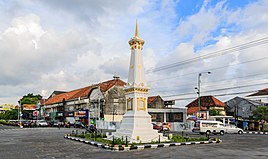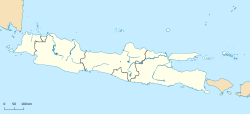
A | B | C | D | E | F | G | H | CH | I | J | K | L | M | N | O | P | Q | R | S | T | U | V | W | X | Y | Z | 0 | 1 | 2 | 3 | 4 | 5 | 6 | 7 | 8 | 9
Yogyakarta
Jogja | |
|---|---|
| City of Yogyakarta Kota Yogyakarta | |
| Regional transcription(s) | |
| • Javanese | ꦔꦪꦺꦴꦒꦾꦏꦂꦠ Ngayogyakarta |
| Nickname(s): | |
| Motto(s): | |
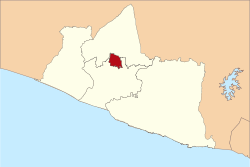 Location within Special Region of Yogyakarta | |
| Coordinates: 7°48′5″S 110°21′52″E / 7.80139°S 110.36444°E | |
| Country | |
| Region | Java |
| Province | |
| Government | |
| • Mayor | Singgih Raharjo (Acting) |
| • Vice Mayor | Vacant |
| Area | |
| • Special region capital | 32.82 km2 (12.67 sq mi) |
| • Metro | 2,159.1 km2 (833.6 sq mi) |
| Elevation | 113 m (371 ft) |
| Population (mid 2023 estimate) | |
| • Special region capital | 375,699 |
| • Density | 11,000/km2 (30,000/sq mi) |
| • Metro | 4,010,436 |
| • Metro density | 1,900/km2 (4,800/sq mi) |
| [1] | |
| Demographics | |
| • Religion[2] |
|
| Time zone | UTC+7 (Indonesia Western Time) |
| Area code | (+62) 274 |
| Vehicle registration |
|
| HDI (2022) | |
| Website | jogjakota.go.id |
| Official name | The Cosmological Axis of Yogyakarta and its Historic Landmarks |
| Criteria | Cultural: (ii), (iii) |
| Reference | 1671 |
| Inscription | 2023 (45th Session) |
| Area | 42.22 ha (104.3 acres) |
| Buffer zone | 291.17 ha (719.5 acres) |
Yogyakarta (English: /ˌjoʊɡjəˈkɑːrtə/ YOHG-yə-KAR-tə;[4] Javanese: ꦔꦪꦺꦴꦒꦾꦏꦂꦠ Ngayogyakarta [ŋɑːˈjɔɡjɔˈkɑːrtɔ]; Petjo: Jogjakarta) is the capital city of the Special Region of Yogyakarta in Indonesia, in the south-central part of the island of Java. As the only Indonesian royal city still ruled by a monarchy, Yogyakarta is regarded as an important centre for classical Javanese fine arts and culture such as ballet, batik textiles, drama, literature, music, poetry, silversmithing, visual arts, and wayang puppetry.[5] Renowned as a centre of Indonesian education, Yogyakarta is home to a large student population and dozens of schools and universities, including Gadjah Mada University, the country's largest institute of higher education and one of its most prestigious.[6][7][8]
Yogyakarta is the capital of the Yogyakarta Sultanate and served as the Indonesian capital from 1946 to 1948 during the Indonesian National Revolution, with Gedung Agung as the president's office. One of the districts in southeastern Yogyakarta, Kotagede, was the capital of the Mataram Sultanate between 1587 and 1613.
The city's population was 388,627 at the 2010 Census,[9] and 373,589 at the 2020 Census;[10] the official estimate as of mid-2023 was 375,699, composed of 182,840 males and 192,859 females.[1] Its metropolitan area was home to 4,010,436 inhabitants in 2010, which includes the city of Magelang and 65 districts across Sleman, Klaten, Bantul, Kulon Progo and Magelang regencies. Yogyakarta has one of the highest HDI (Human Development Index) in Indonesia.[11] To rapidly jumpstart the economy, plan for 2nd phase Indonesia high speed train via Southbound is currently being developed from Bandung to Solo, via Yogyakarta initiating construction by 2023, which projected to be completed by 2026.[12]
Etymology and orthography
Yogyakarta is named after the Indian city of Ayodhya, the birthplace of the eponymous hero Rama from the Ramayana epic. Yogya means "suitable; fit; proper", and karta means "prosperous; flourishing". Thus, Yogyakarta means " fit to prosper".[13]
In colonial era correspondence, the city is often written in the Javanese script as ꦔꦪꦺꦴꦒꦾꦏꦂꦠ,[14] read as /ˌŋɑːjɒɡjəˈkɑːrtə/ with the added prefix nga-.
In the orthography of the time, the proper name was spelt with the Latin alphabet as "Jogjakarta". As the orthography of the Indonesian language changed, the consonant /j/ came to be written with ⟨y⟩, and the consonant /dʒ/ with ⟨j⟩. Personal and geographical names however, were allowed to maintain their original spelling according to contemporary Indonesian orthography. Thus, the city can be written as "Yogyakarta", which is true to its original pronunciation and the Javanese script spelling, or "Jogjakarta", which is true to the old Dutch spelling and reflects popular pronunciation today, but differs from the original Ayodhya etymology. One may encounter either "Yogyakarta" or "Jogjakarta" in contemporary documents.
History
This section needs additional citations for verification. (August 2022) |
Mataram Kingdom (8th–10th century CE)
According to the Canggal inscription dated 732 CE, the area traditionally known as "Mataram" became the capital of the Medang Kingdom, identified as Mdang i Bhumi Mataram established by King Sanjaya of Mataram. The inscription was found in a Hindu temple in Central Java, 40 km away from Yogyakarta and 20 km away from the giant Borobudur temple complex. This Hindu temple itself was on the border between the area of the Hindu Sañjaya dynasty and the area of the Buddhist Shailendra dynasty.
Mataram became the centre of a refined and sophisticated Javanese Hindu-Buddhist culture for about three centuries in the heartland of the Progo River valley, on the southern slopes of Mount Merapi volcano. This time period witnessed the construction of numerous candi, including Borobudur and Prambanan.
Around the year 929 CE, the last ruler of the Sañjaya dynasty, King Mpu Sindok of Mataram, moved the seat of power of the Mataram Kingdom from Central Java to East Java and thus established the Isyana dynasty. The exact cause of the move is still uncertain; however, a severe eruption from Mount Merapi or a power struggle with the Sumatra-based Srivijaya kingdom probably caused the move.[15]
Historians suggest that some time during the reign of King Wawa of Mataram (924–929 CE), Merapi erupted and devastated the kingdom's capital in Mataram.[16][17]
Majapahit Empire (1293–1527)
During the Majapahit era, the area surrounding modern Yogyakarta was identified again as "Mataram" and recognised as one of the twelve Majapahit provinces in Java ruled by Bhre Mataram. During the reign of the fourth king of the Majapahit Empire, the Hindu King Hayam Wuruk (1350–1389) of the Rajasa dynasty, the title of Bhre Mataram was held by the king's nephew and son-in-law Wikramawardhana, later the fifth king of Majapahit.[18]
Mataram Sultanate (1587–1755)
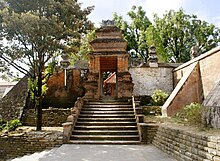
Kotagede, now a district in southeastern Yogyakarta, was established as the capital of the Mataram Sultanate from 1587 to 1613.
During the reign of Sultan Agung Hanyokrokusumo (1613–1645), the Mataram Sultanate reached its zenith as the greatest kingdom in Java, and expanded its influence to Central Java, East Java, and half of West Java. After two changes of capital—to Karta and then to Plered, both located in present-day Bantul Regency—the capital of the Mataram Sultanate finally moved to Kartasura.[citation needed]
Yogyakarta secedes and European invasions (1745–1830)
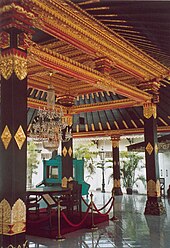
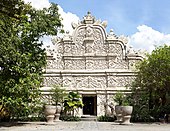
A civil war in the Mataram Sultanate broke out between Pakubuwono II (1745–1749), the last ruler of Kartasura, and his younger brother and heir apparent to the throne, Prince Mangkubumi (later known as Hamengkubuwono I, the first Sultan of Yogyakarta, and the founder of the current ruling royal house). Pakubuwono II had agreed to cooperate with the Dutch East India Company, and ceded some Mataram territory to the Dutch. Prince Mangkubumi, stood against the agreement, citing concerns that the people would become slaves under Dutch rule. During the war, Prince Mangkubumi defeated Pakubuwono II's forces and declared sovereignty in the Sultanate of Yogyakarta, occupying the southern parts of the former Mataram Sultanate.[citation needed]
With Pakubowono II dead from illness, the Yogyakarta Sultanate was established as a result of the Treaty of Giyanti (Perjanjian Gianti), signed and ratified on 13 February 1755 among Prince Mangkubumi, the Dutch East India Company, and his nephew Pakubuwono III and his allies. Ascending to the newly created Yogyakarta throne with the name Sultan Hamengkubuwono I, Mangkubumi thus established the royal House of Hamengkubuwono, still the ruling house of Yogyakarta today. Sultan Hamengkubuwono I and his family officially moved into the Palace of Yogyakarta, still the seat of the reigning sultan, on 7 October 1756. These events consequently marked the end of the Mataram Sultanate, resulting in the births of the rival Yogyakarta Sultanate and the Surakarta Sunanate.[citation needed]
During the brief period of British rule over Java in 1811, rumours of plans by the Yogyakarta court to launch an attack against the British led to uneasiness among the Britons stationed in Java. On 20 June 1812, Sir Stamford Raffles led a 1,200-strong British force to capture the Yogyakarta kraton. The Yogyakarta forces, surprised by the attack, were easily defeated; the kraton fell in one day, and was subsequently sacked and burnt.[19]
The attack on the kraton was the first of its kind in Indonesian history, leaving the Yogyakarta court humiliated. The sultanate found itself involved in conflict again during the Java War.[19]
Republic of Indonesia era (1945–present)
In 1942, the Japanese Empire invaded the Dutch East Indies and ruled Java until they were defeated in 1945. Sukarno proclaimed the independence of the Indonesian Republic on 17 August 1945; Sultan Hamengkubuwono IX promptly sent a letter to Sukarno, expressing his support for the newly born nation of Indonesia and acknowledging the Yogyakarta Sultanate as part of the Indonesian Republic.
The Sultanate of Surakarta did the same, and both of the Javanese kingdoms were accordingly awarded privileged statuses as "Special Regions" within the Indonesian Republic. However, because of a leftist anti-royalist uprising in Surakarta, the Sunanate of Surakarta lost its special administrative status in 1946 and was absorbed into Central Java Province.
Yogyakarta's support was essential in the Indonesian struggle for independence during the Indonesian National Revolution (1945–1949). The city of Yogyakarta became the capital of the Indonesian Republic from 1946 to 1948, after the fall of Jakarta to the Dutch. Later the Dutch also invaded Yogyakarta, causing the Republic's capital to be transferred once again, to Bukittinggi in West Sumatra on 19 December 1948. The General Offensive of 1 March 1949 resulted in an Indonesian political and strategic victory against the Dutch and the withdrawal of Dutch forces from Yogyakarta. On 29 June 1949 Yogyakarta was completely cleared of Dutch forces, under pressure from the United Nations.
For its significant contribution to the survival of the Indonesian Republic, Yogyakarta was given autonomy as a "special district",[20] making it the only region headed by a recognised monarchy in Indonesia.
Geography
The area of the city of Yogyakarta is 32.82 square kilometres (12.7 square miles). While the city spreads in all directions from the Kraton, the Sultan's palace, the core of the modern city is to the north, centred around Dutch colonial-era buildings and the commercial district. Jalan Malioboro, with rows of pavement vendors and nearby markets and malls, is the primary shopping street for tourists in the city, while Jalan Solo, further north and east, is the shopping district more frequented by locals. The large local market of Beringharjo (id) and the restored Dutch fort of Vredeburg are on the eastern part of the southern end of Malioboro.
Surrounding the Kraton is a densely populated residential neighbourhood that occupies land that was formerly the Sultan's sole domain. Evidence of this former use remains in the form of old walls, scattered throughout the city, and the ruins of the Taman Sari water castle, built in 1758 as a pleasure garden. No longer in use by the Sultan, the garden was largely abandoned before being used for housing by palace employees and descendants. Reconstruction efforts began in 2004, and the site is now a popular tourist attraction.
Nearby to the city of Yogyakarta is Mount Merapi, with the northern outskirts of the city running up to the southern slopes of the mountain in Sleman Regency. Mount Merapi (literally "mountain of fire" in both Indonesian and Javanese), is an active stratovolcano located on the border between Central Java and Yogyakarta. It is the most active volcano in Indonesia and has erupted regularly since 1548, with the last eruption occurring in May 2018.
Climate
Yogyakarta features a tropical monsoon climate (Am) as the precipitation in the driest months between June and September are below 100 millimetres (3.9 inches). The wettest month in Yogyakarta is January with precipitation totalling 392 millimetres (15.4 inches). The climate is influenced by the monsoon. The annual temperature is roughly about 26 to 27 Celsius. The hottest month is April with average temperature 27.1 Celsius.
| Climate data for Yogyakarta, Indonesia (elevation 121 m or 397 ft) | |||||||||||||
|---|---|---|---|---|---|---|---|---|---|---|---|---|---|
| Month | Jan | Feb | Mar | Apr | May | Jun | Jul | Aug | Sep | Oct | Nov | Dec | Year |
| Record high °C (°F) | 31 (88) |
32 (90) |
32 (90) |
33 (91) |
32 (90) |
32 (90) |
32 (90) |
32 (90) |
34 (93) |
35 (95) |
35 (95) |
32 (90) |
35 (95) |
| Mean daily maximum °C (°F) | 29.8 (85.6) |
30.5 (86.9) |
31.3 (88.3) |
31.5 (88.7) |
31.1 (88.0) |
31.0 (87.8) |
30.3 (86.5) |
30.7 (87.3) |
31.5 (88.7) |
31.6 (88.9) |
30.9 (87.6) |
30.1 (86.2) |
30.9 (87.5) |
| Daily mean °C (°F) | 26.3 (79.3) |
26.5 (79.7) |
26.6 (79.9) |
27.1 (80.8) |
26.9 (80.4) |
26.2 (79.2) |
25.4 (77.7) |
25.6 (78.1) |
26.4 (79.5) |
27.0 (80.6) |
26.8 (80.2) |
26.4 (79.5) |
26.4 (79.6) |
| Mean daily minimum °C (°F) | 22.9 (73.2) |
22.8 (73.0) |
22.9 (73.2) |
23.0 (73.4) |
22.7 (72.9) |
21.5 (70.7) |
20.6 (69.1) |
20.6 (69.1) |
21.7 (71.1) |
22.7 (72.9) |
23.0 (73.4) |
22.8 (73.0) |
22.3 (72.1) |
| Record low °C (°F) | 20 (68) |
21 (70) |
21 (70) |
21 (70) |
18 (64) |
16 (61) |
17 (63) |
16 (61) |
18 (64) |
21 (70) |
21 (70) |
20 (68) |
16 (61) |
| Average precipitation mm (inches) | 392 (15.4) |
299 (11.8) |
363 (14.3) |
149 (5.9) |
141 (5.6) |
68 (2.7) |
29 (1.1) |
16 (0.6) |
49 (1.9) |
136 (5.4) |
237 (9.3) |
278 (10.9) |
2,157 (84.9) |
| Average relative humidity (%) | 82 | 82 | 81 | 78 | 77 | 74 | 74 | 71 | 69 | 73 | 77 | 82 | 77 |
| Source 1: Climate-Data.org (temp and precip)[21] | |||||||||||||
| Source 2: Weatherbase (temp records & humidity)[22] | |||||||||||||
Administrative districts
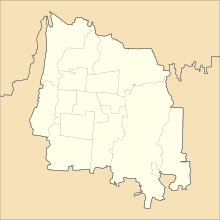
The city of Yogyakarta is an administrative part of the Yogyakarta Special Region which has the status of a province in Indonesia. In 2020, Yogyakarta City held the highest population density in Greater Yogyakarta, with 11,546 people per square kilometre, Sleman and Bantul Regencies holding the second place with a population density of 1,958.5 people/sq kilometre, and third place with 1,940 people/sq kilometre respectively.[23] Within the Greater Yogyakarta area lies Yogyakarta city.
Yogyakarta is divided into fourteen district-level subdivisions called kemantren (Javanese: ꦏꦼꦩꦤ꧀ꦠꦿꦺꦤ꧀), which makes Yogyakarta the only city in Indonesia to have such a designation, as it applied only within the Special Region of Yogyakarta. Below is a list of the kemantrens with their areas and their populations as at the 2010 Census[9] and the 2020 Census,[10] together with the official estimates as at mid 2023.[1] The table also includes the locations of the district administrative centres, the number of administrative villages within each district, and its post codes.
| Kode Wilayah |
Name of District (kemantren) |
Area in km2 |
Pop'n Census 2010 |
Pop'n Census 2020 |
Pop'n Estimate mid 2023 |
Admin centre |
No. of villages |
Post codes |
|---|---|---|---|---|---|---|---|---|
| 34.71.08 | Mantrijeron
ꦩꦤ꧀ꦠꦿꦶꦗꦼꦫꦺꦴꦤ꧀ |
2.67 | 31,267 | 33,340 | 33,664 | Suryodiningratan | 3 | 55141 - 55143 |
| 34.71.09 | Kraton
ꦏꦿꦠꦺꦴꦤ꧀ |
1.38 | 17,471 | 17,943 | 18,024 | Kapipaten | 3 | 55131 - 55133 |
| 34.71.12 | Mergangsan
ꦩꦼꦂꦒꦁꦱꦤ꧀ |
2.30 | 29,292 | 28,739 | 28,869 | Brontokusuman | 3 | 55151 - 55153 |
| 34.71.13 | Umbulharjo
ꦈꦩ꧀ꦧꦸꦭ꧀ꦲꦂꦗ |
8.33 | 76,743 | 68,170 | 68,479 | Warungboto | 7 | 55161 - 55167 |
| 34.71.14 | Kotagede
ꦏꦸꦛꦒꦼꦝꦺ |
2.99 | 31,152 | 33,280 | 33,557 | Prenggan | 3 | 55171 - 55173 |
| 34.71.03 | Gondokusuman
ꦒꦤ꧀ꦢꦏꦸꦱꦸꦩꦤ꧀ |
3.99 | 45,293 | 36,921 | 37,088 | Demangan | 5 | 55221 - 51225 |
| 34.71.04 | Danurejan
ꦢꦤꦸꦸꦉꦗꦤ꧀ |
1.11 | 18,342 | 18,670 | 18,851 | Bausasran | 3 | 55211 - 55213 |
| 34.71.11 | Pakualaman
ꦥꦏꦸꦮꦭꦩ꧀ꦩꦤ꧀ |
0.65 | 9,316 | 9,148 | 9,189 | Gunungketur | 2 | 55111 - 55112 |
| 34.71.10 | Gondomanan
ꦒꦤ꧀ꦢꦩꦤꦤ꧀ |
1.14 | 13,029 | 12,793 | 12,851 | Prawirodirjanpectr | 2 | 55121 - 55122 |
| 34.71.06 | Ngampilan
ꦔꦩ꧀ꦥꦶꦭ꧀ꦭꦤ꧀ |
0.84 | 16,320 | 15,358 | 15,428 | Notoprajan | 2 | 55261 - 55262 |
| 34.71.07 | Wirobrajan
ꦮꦶꦫꦧꦿꦗꦤ꧀ |
1.77 | 24,840 | 24,739 | 24,851 | Patangpuluhan | 3 | 55251 - 55253 |
| 34.71.05 | Gedongtengen
ꦒꦼꦝꦺꦴꦁꦠꦼꦔꦼꦤ꧀ |
0.99 | 17,185 | 16,484 | 16,559 | Pringgokusuman | 2 | 55271 - 55272 |
| 34.71.02 | Jetis
ꦗꦼꦛꦶꦱ꧀ |
1.72 | 23,454 | 23,385 | 23,491 | Bumijo | 3 | 55231 - 55233 |
| 34.71.01 | Tegalrejo
ꦠꦼꦒꦭ꧀ꦉꦗ |
2.96 | 34,923 | 34,619 | 34,798 | Tagalrejo | 4 | 55241 - 55244 |
| Totals | 32.82 | 388,627 | 373,589 | 375,699 | 45 |
Economy
In 2017, the Gross Domestic Regional Product (GRDP) of Yogyakarta City at current prices was 31.31 trillion rupiahs (around US$ 2.2 billion).[24] The tertiary sector contributed an important share (around 78% of GDP). the tertiary sector included wholesale and retail trade; repair of cars and motorcycles, transportation and warehousing; provision of accommodation and eating and drinking; information and communication; financial services and insurance; real estate; corporate services; government administration, defence and compulsory social security; educational services; health services and social activities as well as other services. In 2017, economic growth of Yogyakarta City reached 5.24 percent slightly faster compared to 2016, which the growth reached 5.11 percent.[25][24][26]
To rapidly jumpstart the economy, a plan for the 2nd phase of Indonesian high speed train is currently being developed from Bandung to Yogyakarta & Solo, initiating construction by 2020, which is projected to be completed by 2024.[27] This proposal would connect to other high-speed rail in Indonesia.
Demographics
A large majority of the population are Javanese. However, as a city with large numbers of schools and universities and a relatively low cost of living compared to other Indonesian cities, Yogyakarta has attracted significant numbers of students from all over Indonesia. As a result, there are many other Indonesian ethnic groups living in Yogyakarta, especially from eastern parts of Indonesia.
There are some foreigner communities in the city, which is mainly composed of tourist and foreign students.
Religion
In 2014, the religious composition in Yogyakarta was distributed over Islam (82.32%), Catholicism (10,66%), Protestantism (6.54%), Buddhism (0.34%), Hinduism (0.13%), and Confucianism (0.01%).
Yogyakarta has been traditionally known as a region where different faiths live in harmony, but in recent years religious intolerance has grown.[28]
In 2018, the governor of the Special Region of Yogyakarta, Hamengkubuwono X, called for religious freedoms to be preserved after a terrorist attack against churches and public buildings in Surabaya the same year.
Antropológia
Aplikované vedy
Bibliometria
Dejiny vedy
Encyklopédie
Filozofia vedy
Forenzné vedy
Humanitné vedy
Knižničná veda
Kryogenika
Kryptológia
Kulturológia
Literárna veda
Medzidisciplinárne oblasti
Metódy kvantitatívnej analýzy
Metavedy
Metodika
Text je dostupný za podmienok Creative
Commons Attribution/Share-Alike License 3.0 Unported; prípadne za ďalších
podmienok.
Podrobnejšie informácie nájdete na stránke Podmienky
použitia.
www.astronomia.sk | www.biologia.sk | www.botanika.sk | www.dejiny.sk | www.economy.sk | www.elektrotechnika.sk | www.estetika.sk | www.farmakologia.sk | www.filozofia.sk | Fyzika | www.futurologia.sk | www.genetika.sk | www.chemia.sk | www.lingvistika.sk | www.politologia.sk | www.psychologia.sk | www.sexuologia.sk | www.sociologia.sk | www.veda.sk I www.zoologia.sk

